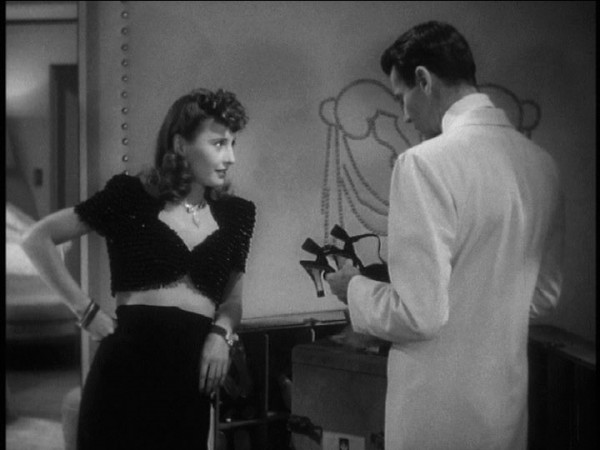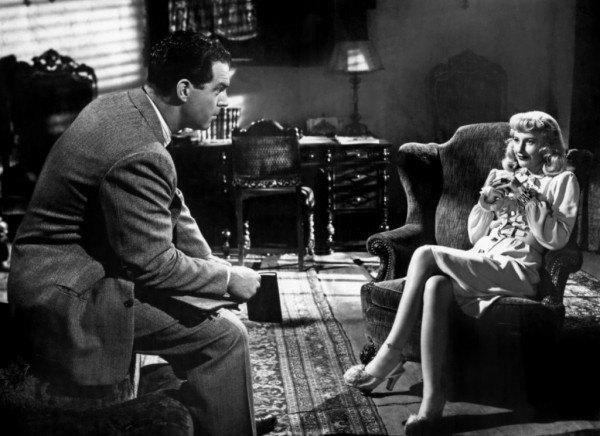DOUBLE INDEMNITY (Billy Wilder, 1944) / THE LADY EVE (Preston Sturges, 1941)
Film Forum
209 West Houston St.
Saturday, December 7: Double Indemnity 1:30, 5:30, 9:30, The Lady Eve 3:40, 7:40
Series runs December 6-31
212-727-8110
www.filmforum.org
 There are plenty of great double features in Film Forum’s nearly four-week retrospective of Barbara Stanwyck, but none are as ingenious as the pairing of Billy Wilder’s Double Indemnity with Preston Sturges’s The Lady Eve. In both black-and-white pictures, Stanwyck excels as an alluring, tough-talking swindler teamed up with a major American actor playing against type. (And each film also features at least one extremely clunky, head-scratching cut.) In 1941, a brunette Stanwyck, who was born Ruby Catherine Stevens in Brooklyn, played the title character in The Lady Eve; while it’s usually lumped in with the classic screwball comedies, Sturges’s film, based on an original story by Irish playwright Monckton Hoffe (who was nominated for an Oscar), is much darker and slower than its supposed brethren. A brunette Stanwyck is first seen as Jean Harrington, a con artist looking to trick a wealthy man on a cruise ship. At her side is her father, “Colonel” Harrington (Charles Coburn), a gambler and a cheat. As soon as Jean sees rich ale scion Charles Pike (a wonderfully innocent Henry Fonda), she digs her claws into the shy, humble man, challenging the Hays Code as she shows off her gams and leans into him with a heart-pounding sexiness. Pike of course falls for Jean, but when his right-hand man, Muggsy (William Demarest), discovers that she regularly preys on suckers, Charles is devastated. However, in this case, Jean’s feelings might actually be real, forcing her to go to extreme circumstances to try to get him back. Stanwyck is, well, a ball of fire as Jean/Eve, determined to win at all costs. Fonda, not usually known for his comedic abilities, is a riot as poor Hopsie, as Jean calls him; the looks on his face when she ratchets up the sex appeal are priceless, and a later scene when he keeps falling down at a party displays a surprising flair for physical comedy. The opening and closing credits feature a corny animated snake in the Garden of Eden; in The Lady Eve, Stanwyck offers the apple, and Fonda can’t wait to take a bite. And there’s nothing shameful about that.
There are plenty of great double features in Film Forum’s nearly four-week retrospective of Barbara Stanwyck, but none are as ingenious as the pairing of Billy Wilder’s Double Indemnity with Preston Sturges’s The Lady Eve. In both black-and-white pictures, Stanwyck excels as an alluring, tough-talking swindler teamed up with a major American actor playing against type. (And each film also features at least one extremely clunky, head-scratching cut.) In 1941, a brunette Stanwyck, who was born Ruby Catherine Stevens in Brooklyn, played the title character in The Lady Eve; while it’s usually lumped in with the classic screwball comedies, Sturges’s film, based on an original story by Irish playwright Monckton Hoffe (who was nominated for an Oscar), is much darker and slower than its supposed brethren. A brunette Stanwyck is first seen as Jean Harrington, a con artist looking to trick a wealthy man on a cruise ship. At her side is her father, “Colonel” Harrington (Charles Coburn), a gambler and a cheat. As soon as Jean sees rich ale scion Charles Pike (a wonderfully innocent Henry Fonda), she digs her claws into the shy, humble man, challenging the Hays Code as she shows off her gams and leans into him with a heart-pounding sexiness. Pike of course falls for Jean, but when his right-hand man, Muggsy (William Demarest), discovers that she regularly preys on suckers, Charles is devastated. However, in this case, Jean’s feelings might actually be real, forcing her to go to extreme circumstances to try to get him back. Stanwyck is, well, a ball of fire as Jean/Eve, determined to win at all costs. Fonda, not usually known for his comedic abilities, is a riot as poor Hopsie, as Jean calls him; the looks on his face when she ratchets up the sex appeal are priceless, and a later scene when he keeps falling down at a party displays a surprising flair for physical comedy. The opening and closing credits feature a corny animated snake in the Garden of Eden; in The Lady Eve, Stanwyck offers the apple, and Fonda can’t wait to take a bite. And there’s nothing shameful about that.
Three years later, a blonde Stanwyck is looking for a way out of her loveless marriage when opportunity knocks in the form of acerbic insurance salesman Walter Neff (Fred MacMurray) in one of the grandest film noirs ever, Double Indemnity. Stanwyck stars as femme fatale Phyllis Dietrichson, who falls for Neff and soon convinces him that they should do away with her husband (Tom Powers). They’re both in it “straight down the line,” as she repeats throughout the film, but insurance fraud investigator Barton Keyes (Edward G. Robinson) isn’t so sure that Mr. Dietrichson’s death was an accident. John F. Seitz’s inventive black-and-white cinematography — watch for those Venetian blind shadows — set the standard for the genre. MacMurray, who had to be persuaded by Wilder to take the part because he thought he’d be awful in the role, is sensational as Neff, oh-so-cool as he recites his cynical dialogue and lights matches with one hand. He might think he’s tough, but he’s no match for Stanwyck, who rules the roost. Both Stanwyck and MacMurray would go on to successful careers in television in the 1960s, he in My Three Sons (with Sturges regular Demarest), she in The Big Valley. Directed by Wilder from a script he wrote with Raymond Chandler based on a pulp novel by James Cain, with music by Miklós Rózsa — how’s that for a pedigree? — Double Indemnity, which was nominated for seven Oscars and won none, is screening on December 7 as part of a twin bill with The Lady Eve at Film Forum, which is celebrating Stanwyck in conjunction with the first major biography of the glamorous star, Victoria Wilson’s A Life of Barbara Stanwyck: Steel-True 1907-1940; Wilson will be introducing several films over the course of the series, which runs December 6-31, and will give an illustrated talk on December 8.

